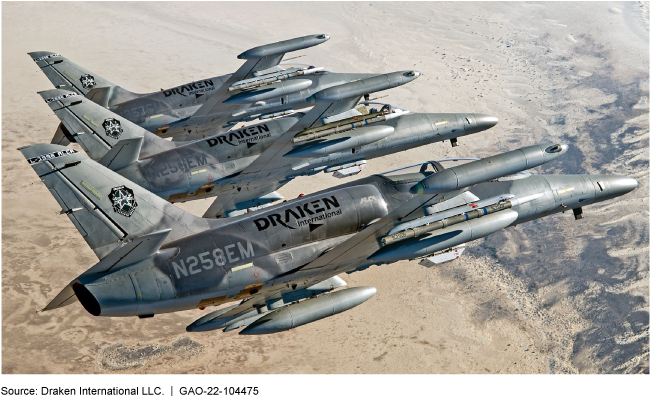Military Air Support: DOD Has Increased Its Use of Contracts to Meet Training Requirements
Fast Facts
The Department of Defense hires private companies to provide "enemy" aircraft for U.S. military training. DOD awarded almost $8.4 billion for these air support contracts in FY 2015 through 2020.
We found contract awards for air support have increased since FY 2015. For example, the Air Force awarded an air support contract for $83 million in 2015 and awarded a $6.4 billion contract in 2020.
The Navy, Marine Corps, and Air Force are reviewing their use of these contracts to support training. For example, a Navy review is studying the optimal mix of live, virtual, and other training, which could help determine the future role of contract aircraft.
Example of Contractor-Provided Aircraft

Highlights
What GAO Found
Department of Defense (DOD) components use air support contracts for certain training activities. Such contracts have supported DOD training at locations in the United States, Europe, and Japan (see figure).
DOD Training Locations with Air Support Contracts

Since fiscal year 2015, DOD components have increased the availability of air support contract flying hours and expanded the number of training locations to address some training needs (see figure). The Air Force, Navy, and Marine Corps have used air support contracts to replicate adversary air forces to train new fighter pilots and to support training exercises. DOD components have also used the contracts to train air controllers on close air support procedures.
DOD Available Flying Hours and Number of Training Locations for Air Support Contracts

Note: Figures include data for available flying hours and training locations for the contract award year, and do not reflect the cumulative total of the available flying hours or locations across all contracts in a fiscal year, which would be greater.
DOD components have taken steps to gain greater efficiencies in the use of air support contracts. These steps included consolidating contract administration to reduce redundant costs, among others. DOD components have also established processes to monitor the performance of air support contracts to meet established contracted requirements. The Air Force, Navy, and Marine Corps have taken steps to determine the effectiveness of these contracts, including evaluating the role of air support contracts among other future options for their adversary air training programs. In particular, the services are determining the appropriate mix of training capabilities, to include contract aircraft, as well as affordability and timeframes to modernize U.S. military adversary air capabilities. These reviews, to be completed in fiscal year 2022, are expected to affect future investments in air support contracts, according to DOD officials.
Why GAO Did This Study
DOD components awarded almost $8 billion for air support contracts in fiscal years 2015 through 2020. These contracts provide non-military aircraft and personnel to replicate the role of combat aircraft for various training activities. The components used the contracts to meet training needs, address shortages in available military aircraft, and manage costs.
House Report 116-442, accompanying a bill for the National Defense Authorization Act for Fiscal Year 2021, included a provision for GAO to review the use of air support contracts during military training. This report describes (1) how DOD has used air support contracts for training to replicate adversary air forces and to provide aircraft for close air support since fiscal year 2015, and (2) what steps DOD has taken to gain efficiencies and determine the effectiveness of air support contracts.
GAO reviewed documentation on air support contracts for fiscal years 2015 through 2021, including performance work statements, task orders, and invoices; analyzed the increase or decrease in the use of air support contracts, including the number of contracts and operating locations; and interviewed officials to determine factors contributing to any increases or decreases in the use of the contracts. GAO also reviewed documentation on specific initiatives DOD components have taken since 2015 to gain greater efficiencies and to determine the effectiveness of air support contracts in achieving training requirements.
For more information, contact Cary Russell at (202) 512-5431 or russellc@gao.gov.
